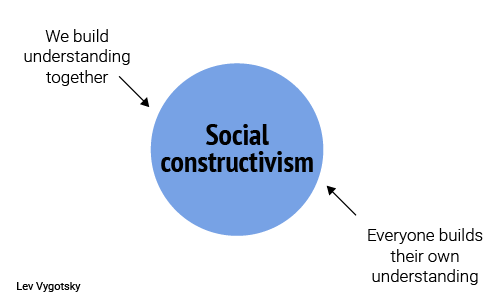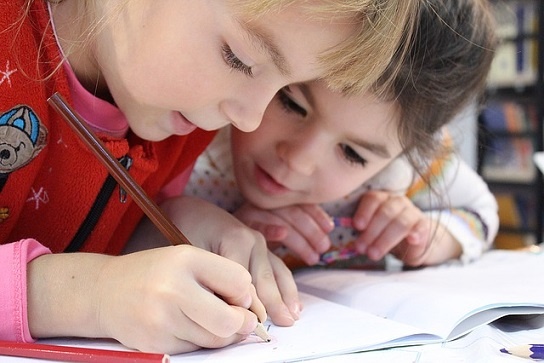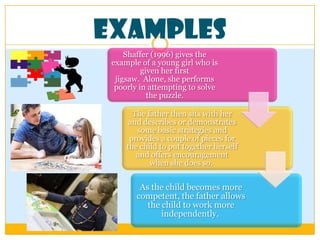Lev Vygotsky was a Russian psychologist and educational theorist who is best known for his theory of cognitive development. Vygotsky believed that social interactions and experiences are critical for the development of higher mental functions and that a child's development is influenced by the culture and society in which they live. He also emphasized the importance of language and communication in the development of thought and reasoning.
One of the key concepts in Vygotsky's theory is the "zone of proximal development," or ZPD. The ZPD refers to the gap between a child's current level of understanding or ability and their potential level of understanding or ability with the guidance of a more skilled or knowledgeable individual. According to Vygotsky, it is through interactions within the ZPD that a child can learn and develop new skills and understanding.
One way that Vygotsky's theory can be applied in practice is through the use of scaffolding in education. Scaffolding refers to the support and guidance provided by a teacher or more skilled peer to help a student learn a new skill or concept. The teacher or peer begins by providing a high level of support and gradually reduces the level of support as the student becomes more proficient. This helps the student to gradually develop their own understanding and independence.
Another way that Vygotsky's theory can be applied in practice is through the use of collaborative learning. Vygotsky believed that social interactions and communication are crucial for the development of higher mental functions, and collaborative learning is a way to encourage social interaction and communication among students. For example, a teacher could have students work in small groups to solve a problem or complete a project, encouraging them to discuss and share ideas and to rely on each other for support and guidance.
Vygotsky's theory also emphasizes the importance of language and communication in the development of thought and reasoning. Teachers can apply this aspect of the theory in practice by using language to scaffold learning and by providing opportunities for students to engage in discussions and debates. For example, a teacher might ask open-ended questions that encourage students to think critically and express their ideas in their own words.
Overall, Vygotsky's theory provides a valuable framework for understanding how children learn and develop. By applying the concepts of the ZPD, scaffolding, and collaborative learning in their teaching, educators can create a rich and supportive learning environment that helps students to reach their full potential.
Vygotsky Theory in blog.sigma-systems.com

ZPD Because Vygotsky asserts that cognitive change occurs within the zone of proximal development, instruction would be designed to reach a developmental level that is just above the student's current developmental level. Vygotsky sought to understand how people learn in a social environment and created a unique theory on social learning. Eventually, the child assumes full responsibility for the task with the expert present still in the role of a supportive audience. The young child alone cannot figure out how the various shapes can fit into the designated holes. The teacher asks the student to first test his hypothesis by hitting the other bottles, listening for the sound and commenting on the level of water that accompanies the sound coming from each bottle; thus allowing the child to make a correlation between the pitch and the amount of water in the bottle. She will begin to classify these items herself when she sees cars, trucks and boats in real-life settings. It is a social constructivist approach to development.
Vygotsky's Theory of Cognitive Development Stages & Examples

How a teacher can use Piaget theory in the classroom? Learning occurs in the zone of proximal development after the identification of current knowledge. He developed his theories at around the same time as Like Piaget, Vygotsky could be described as a No single principle such as Piaget's equilibration can account for development. According to the sociocultural perspective, our psychological growth is guided, in part, by people in our lives who are in mentor-type roles, such as teachers and parents. Then, the child practices while the father watches. Moreover, egocentric speech is an important transitional stage between social speech and inner speech.
What is Vygotsky's theory quizlet?

If you form groups with mixed mastery levels, the advanced students can help those who are less advanced. Vygotsky focused on the connection between people and the sociocultural context in which they act and interact in shared experiences. We can see that the teacher brought the child beyond the limit of what he can achieve on his own, into the ZPD, and continued to raise the level of challenge and level of reasoning required by increasing the complexity of the task. More Knowledgeable Other The more knowledgeable other MKO is somewhat self-explanatory; it refers to someone who has a better understanding or a higher ability level than the learner, with respect to a particular task, process, or concept. Adults convey to children the way their culture interprets and responds to the world.
Lev Vygotsky's Sociocultural Theory

And hey, if your tot still doesn't know her left from her right, don't worry -- surely, she will bump into many other MKOs in the years to come! Once the child rides the bicycle independently, his ZPD shifts upward and may include hands-free riding or stunts. Try to ignore the strange looks you get as you blabber away to yourself. Students learn through observation, listening and talking through their tasks. Egnlewood, Co: Libraries Unlimited. Here are some examples of scenarios that occur in everyday life.
Sociocultural Theory: Understanding Vygotsky's Theory

He rejected the assumption made by Piaget that it was possible to separate learning from its social context. Try not to be an overbearing Mamazilla and do things for her, but provide just enough help in order for her to accomplish something difficult and feel like a million bucks. Scaffolding and reciprocal teaching are effective strategies to access the zone of proximal development. The teacher then again asks a leading question and moves further into the zone of proximal development, hoping to lead the child upwards in reasoning and cognition: What sound do you have now, a high or a low sound? According to Vygotsky, in order to get a true assessment of a child's actual and potential development, we should assess capabilities both when the child is performing the activity alone and with a more competent individual. Effects of Culture: - Tools of intellectual adaptation Vygotsky claimed that infants are born with the basic abilities for intellectual development called 'elementary mental functions' Piaget focuses on motor reflexes and sensory abilities. Cognitively Guided Instruction is another strategy to implement Vygotsky's theory. What is a real life example of Lev Vygotsky theory? Teacher education quarterly, 27-38.
The Theories of Lev Vygotsky in the Classroom

Journal of Learning Disabilities, 40, 2—14. Demonstrate self-talk for your tot. During scaffolding the support offered by a adult or more knowledgeable other gradually decreases as the child becomes more skilled in the task. Once the child has acquired some mastery or expertise in one part of the task, additional parts may then be stacked onto the original, incrementally, as the child grasps each part of the concept. By using Piaget's theory in the classroom, teachers and students benefit in several ways. Br J Educ Psychol.








